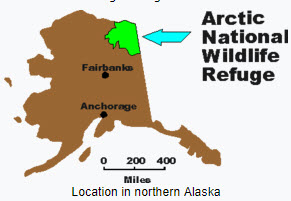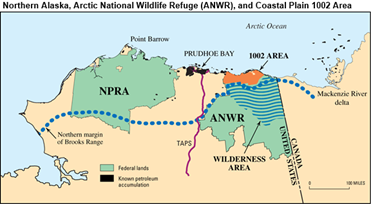Drilling in Arctic National Wildlife Refuge One Step Closer
The U.S. Department of the Interior has taken another step towards allowing oil and gas drilling in Alaska's Arctic National Wildlife Refuge by issuing a draft environmental impact statement for the leasing program proposed for the 1002 Area (coastal plain).
 In 2017, Congress mandated the U.S. Secretary of the Interior to establish a program for the development of the Coastal Plain, and last week the Bureau of Land Management released the Draft Environmental Impact Statement for the Coastal Plain Oil and Gas Leasing Program for public review and comment. The first lease sale will be held after the Final EIS and Record of Decision is issued and will offer over 400,000 acresfor bid.
In 2017, Congress mandated the U.S. Secretary of the Interior to establish a program for the development of the Coastal Plain, and last week the Bureau of Land Management released the Draft Environmental Impact Statement for the Coastal Plain Oil and Gas Leasing Program for public review and comment. The first lease sale will be held after the Final EIS and Record of Decision is issued and will offer over 400,000 acresfor bid.
"An energy-dominant America starts with an energy-dominant Alaska, and among the scores of accomplishments we have had at Interior under President Donald J. Trump, taking these steps toward opening the 1002 section of Alaska's North Slope stands out among the most impactful toward bolstering America's economic strength and security," said U.S. Secretary of the Interior Ryan Zinke.
"Alaskans have anticipated the release of the draft environmental statement for decades," said Alaska Gov. Michael J. Dunleavy. "My administration and Alaskans overwhelmingly support Arctic National Wildlife Refuge development, and we are eager to inform and educate our fellow Americans that it will be done utilizing the highest environmental standards and safeguards to protect its land, waters and wildlife."
 The American Petroleum Institute (API) says the coastal plain is a small portion of Arctic National Wildlife Refuge. API Director of Upstream and Industry Operations Erik Milito. “Responsible access to the Arctic region is in our national security interest, with other nations like Russia, Canada and Norway already actively exploring the area.”
The American Petroleum Institute (API) says the coastal plain is a small portion of Arctic National Wildlife Refuge. API Director of Upstream and Industry Operations Erik Milito. “Responsible access to the Arctic region is in our national security interest, with other nations like Russia, Canada and Norway already actively exploring the area.”
According to a 2005 review by the U.S. Geological Survey, the 1002 Area contains an estimated 10.4 billion barrels of oil. At peak production, the 1002 Area could supply up to 1.45 million barrels of oil per day. Opening a small portion of the coastal plain to energy production could create tens of thousands of American jobs and contribute to significant economic growth, says the API. In addition, development is estimated to bring in between $150 billion and $296 billion in new federal revenue.
At 19.3 million acres, the refuge is home to some of the most diverse and iconic populations of wildlife in the Arctic, including polar and grizzly bears, wolves and the Porcupine caribou herd. Set between the foothills of the Brooks Range and the Arctic Ocean, the refuge’s coastal plain contains the most important land denning habitat for polar bears across America’s Arctic coast. Birds from all 50 states migrate to the refuge, including the snowy owl and semipalmated sandpiper.
The Center for Biological Diversity says that publicly the administration promised a fair and robust review process. In reality it has placed arbitrary deadlines and limitations on the environmental review every step of the way.
“The Gwich’in nation opposes any development in the calving grounds of the Porcupine Caribou Herd,” said Bernadette Demientieff, executive director of the Gwich’in Steering Committee. “The rush and fast pace that they are moving in only proves that they have no intention of addressing our concerns. 95 percent of the Arctic is opened to oil and gas. Leave the remaining five percent alone. Our animals need somewhere clean and healthy to go. That’s what the coastal plain provides: a refuge for our animals. The Gwich’in have a cultural and spiritual connection to the Porcupine caribou herd. Drilling in the Arctic Refuge is a direct attack on our way of life.”
“Of all of the Trump administration’s conservation rollbacks, the drive to sell off one of America’s wildest places for dirty, high-risk oil-drilling ranks among the worst,” said Jamie Williams, president of The Wilderness Society. “Americans have no desire to drill the Arctic Refuge, and this action is pure pandering to special interests in the oil lobby.”
“Nothing could be more reckless than drilling for oil in a wildlife refuge,” said Kierán Suckling, executive director of the Center for Biological Diversity. “Once we industrialize our last great Alaskan wilderness areas, there’s no going back. The Arctic National Wildlife Refuge is where we must make a stand against Trump’s ignorance and greed. Here is where we protect our environment or accept climate chaos and the extinction crisis."
